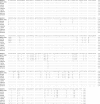Neisseria gonorrhoeae isolates with reduced susceptibility to cefixime and ceftriaxone: association with genetic polymorphisms in penA, mtrR, porB1b, and ponA
- PMID: 17420216
- PMCID: PMC1891421
- DOI: 10.1128/AAC.01604-06
Neisseria gonorrhoeae isolates with reduced susceptibility to cefixime and ceftriaxone: association with genetic polymorphisms in penA, mtrR, porB1b, and ponA
Abstract
The recent emergence and transmission of Neisseria gonorrhoeae isolates with reduced susceptibility to expanded-spectrum cephalosporins such as cefixime and ceftriaxone have been reported. The aim of this study was to determine the correlation of different polymorphisms in the penA, mtrR, porB1b (penB), and ponA genes of N. gonorrhoeae with reduced susceptibility to cefixime and ceftriaxone. Eighteen gonococcal isolates with reduced cefixime and ceftriaxone susceptibility (Cef(i)) and two susceptible isolates were characterized using serovar determination, antibiograms, N. gonorrhoeae multiantigen sequence typing (NG-MAST), and sequencing of penA, mtrR, porB1b, and ponA alleles. For the Cef(i) isolates (n = 18), the MICs of cefixime and ceftriaxone ranged between 0.032 to 0.38 mug/ml and 0.064 to 0.125 mug/ml, respectively. These isolates were assigned five different serovars and six divergent NG-MAST sequence types. Eleven isolates (61%) with higher MICs of cefixime and ceftriaxone contained a nearly identical penA mosaic allele and previously described polymorphisms in mtrR (a single nucleotide [A] deletion in the promoter), penB (mutations in porB1b encoding loop 3 of PorB1b), and ponA (ponA1 polymorphism). The remaining seven Cef(i) isolates (39%), which had somewhat lower MICs of cefixime and ceftriaxone, contained an aspartic acid insertion (Asp-345a) in PBP 2 in conjunction with alterations of 4 to 10 amino acid residues in the C-terminal region of the transpeptidase domain of penA. In conclusion, an unambiguous association between penA mosaic alleles, in conjunction with genetic polymorphisms in mtrR, porB1b, and ponA, and greater reduced susceptibility to cefixime and ceftriaxone was identified.
Figures

References
-
- Ameyama, S., S. Onodera, M. Takahata, S. Minami, N. Maki, K. Endo, H. Goto, H. Suzuki, and Y. Oishi. 2002. Mosaic-like structure of penicillin-binding protein 2 gene (penA) in clinical isolates of Neisseria gonorrhoeae with reduced susceptibility to cefixime. Antimicrob. Agents Chemother. 46:3744-3749. - PMC - PubMed
-
- Australian Gonococcal Surveillance Programme. 2006. Annual report of the Australian Gonococcal Surveillance Programme. Commun. Dis. Intell. 30:205-210. - PubMed
-
- Berglund, T., M. Unemo, P. Olcén, J. Giesecke, and H. Fredlund. 2002. One year of Neisseria gonorrhoeae isolates in Sweden: the prevalence study of antibiotic susceptibility shows relation to the geographic area of exposure. Int. J. STD AIDS 13:109-114. - PubMed
-
- Boslego, J. W., E. C. Tramont, E. T. Takafuji, B. M. Diniega, B. S. Mitchell, J. W. Small, W. N. Khan, and D. C. Stein. 1987. Effect of spectinomycin use on the prevalence of spectinomycin-resistant and penicillinase-producing Neisseria gonorrhoeae. N. Engl. J. Med. 317:272-278. - PubMed
-
- CDC. 2005. Sexually transmitted disease surveillance 2004 supplement: Gonococcal Isolate Surveillance Project (GISP) annual report—2004. CDC, Atlanta, GA.
Publication types
MeSH terms
Substances
LinkOut - more resources
Full Text Sources
Other Literature Sources
Medical
Molecular Biology Databases
Research Materials
Miscellaneous

